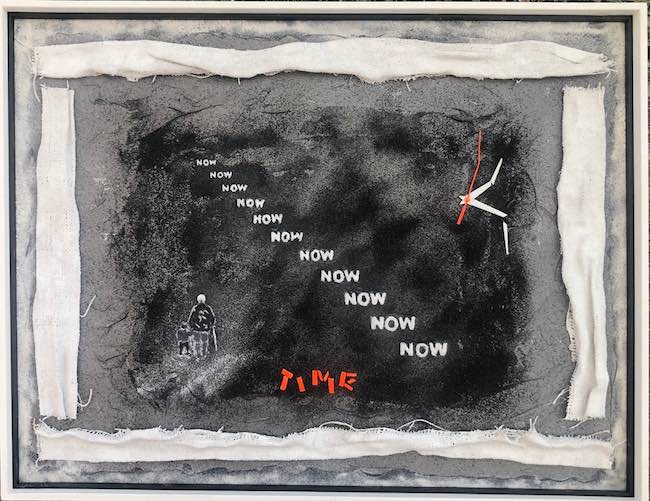Il concetto dello scorrere del tempo, della sua fluidità o in alcuni casi della sua immobilità è stato più volte affrontato nel corso della storia dell’arte, perché in fondo costituisce quel sottile filo su cui si muovono le vite degli individui senza che sia possibile scoprirne la reale consistenza; nell’epoca contemporanea dove tutto sembra essere ricondotto al momento presente, e non inteso nel senso orientale dell’apprezzare l’istante vissuto bensì in quello occidentale del non avere una visione lungimirante né in grado di apprendere dal passato, molti artisti sentono il bisogno di entrare in quella misteriosa dimensione, di esplorarla e di osservarne ogni risvolto, ogni collegamento con il loro vivere. L’artista di cui vi parlerò oggi incentra quasi tutta la sua produzione su questo effimero e al tempo stesso indispensabile elemento dell’esistenza.
Nel corso del Novecento furono introdotti dalle varie correnti artistiche che si affiancarono e si susseguirono dinamicamente risultando di fatto collegate se non dal punto di vista stilistico sicuramente da quello dell’approfondimento della psiche e dell’interiorità, nuovi significati che nell’arte precedente erano mancati, a parte per la breve parentesi del Simbolismo che però si era occupato prevalentemente del contatto con le energie divine e soprannaturali, con l’essenza stessa delle cose intorno all’essere umano; nel Ventesimo secolo invece tutti i movimenti che vollero mantenere il contatto con la figurazione, dal Futurismo al Surrealismo, dal Cubismo alla Metafisica, introdussero concetti più esistenziali, più legati a una consapevolezza sostanziale che nell’arte precedente sembrava essere stata lasciata in disparte. Già nel gruppo fondato da Filippo Tommaso Marinetti e Umberto Boccioni, le linee guida evidenziavano la necessità di trovare un modo per esprimere il senso di movimento e di velocità affine alla nuova modernità, a quegli inizi del secolo in cui le innovazioni tecnologiche e scientifiche avevano provocato una rapida accelerazione del progredire della società; il tempo pertanto entrava in modo diretto all’interno delle loro opere costituendone un elemento essenziale. Salvador Dalì invece ne sottolineò più volte la fluidità, quello sciogliersi letteralmente perché il suo scorrere costituiva un’ossessione del grande maestro catalano, una dei pochi eventi, delle rare circostanze che non poteva gestire, né arginare; in questo caso pertanto l’accezione era più negativa che positiva, che contraddistingueva invece le opere di Marinetti, perché il grande surrealista sapeva di doversi piegare a esso malgrado il desiderio di resistere e fermarlo. Eppure dalle sue tele emergono atmosfere immobili, quasi post-apocalittiche, in contrasto con la consapevolezza del fluire che avvolgeva la sua mente divenendo un ostacolo alla ricerca spensierata del piacere in ogni sua accezione. E ancora il Cubismo si avvalse della contemporaneità dell’osservazione, quell’indurre il fruitore a trovarsi davanti simultaneamente una realtà bidimensionale eliminando pertanto il tempo di prendere in esame altri lati dei volti ritratti così come invece Giorgio De Chirico si occupò dell’immaterialità delle sue ambientazioni, di quell’essere sospese in un’atmosfera in cui passato e presente si confondevano, in cui ciò che era stato diveniva silenziosamente sfondo per ciò che si stava apprestando a essere infondendo un senso di estraniamento e solitudine.
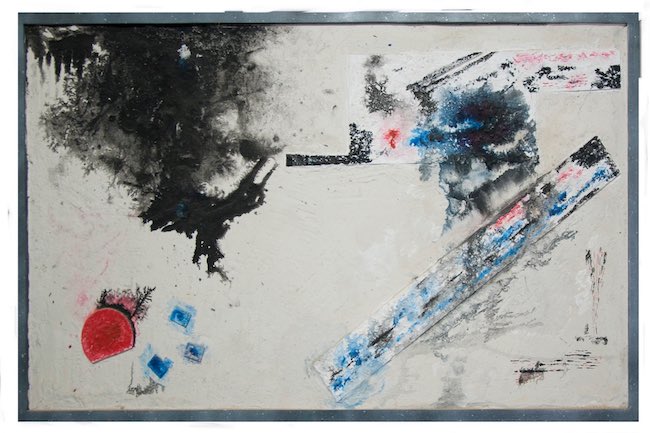
L’artista campano Giancarlo Mariniello si lega profondamente al concetto del tempo esplorandolo però attraverso l’Espressionismo Astratto, dal punto di vista pittorico, attraverso l’Astrattismo dal punto di vista scultoreo e con l’Informale Materico quando mescola la sua naturale curiosità verso lo scorrere delle ore, dei giorni, degli anni, con l’attitudine a creare oggetti che controllino ma al tempo stesso rendano consapevoli del suo inesorabile fluire come la serie degli Orologi in cui la vernice a olio impregna il legno per evidenziare le ore mentre in trasparenza diventano evidenti momenti, ricordi, piccoli frammenti che si legano alla terra di mezzo tra passato e presente.
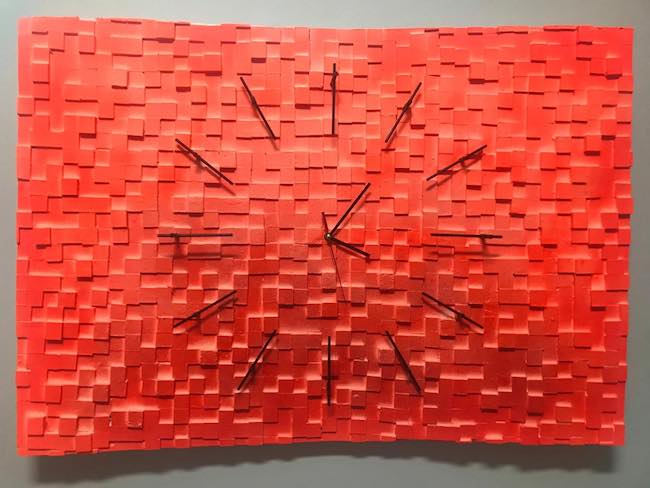
Non solo, Mariniello è affascinato anche da tutte le derivazioni e le implicazioni che scaturiscono dalla sua osservazione di tutto ciò che si lega al concetto dello scorrere, della perpetua fluidità all’interno della quale si susseguono circostanze, accadimenti che nel frangente successivo appartengono al ricordo.
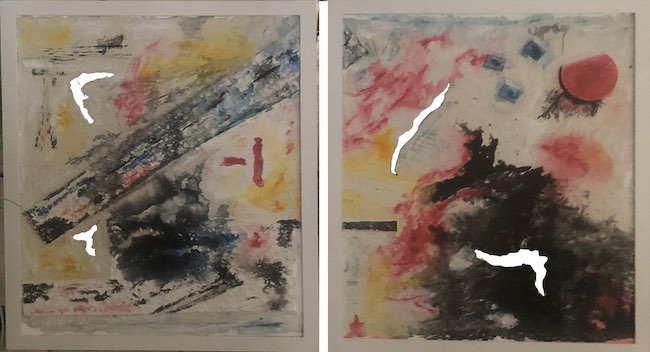
Anche quando rivolge l’attenzione all’essenza di un momento vissuto o di una persona che è passata nella sua vita, lo fa sempre lasciando trasparire la nostalgia, quell’appartenenza di ogni istante a un evento o un incontro che appartengono al passato e che sembrano aver lasciato la scia in un’esistenza che non può fare a meno di andare avanti, a prescindere dalla volontà dell’essere umano di volerla arrestare, di volersi aggrappare per impedire ai frangenti più piacevoli di scorrere via.
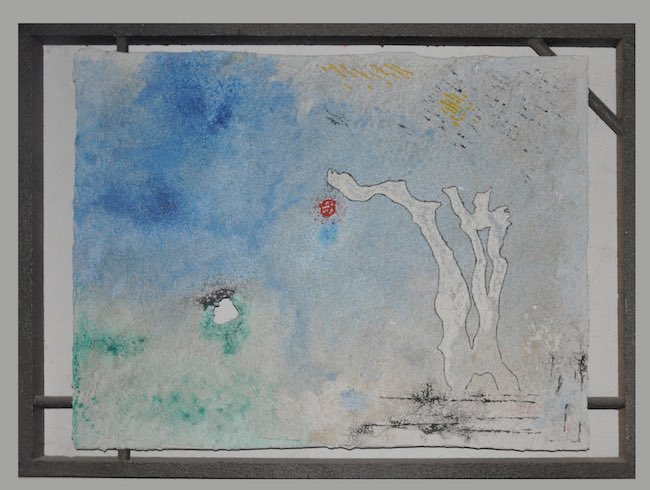
Nell’opera Figura di donna si intravede una sottile figurazione, non dell’immagine femminile citata nel titolo bensì nell’albero che costituisce la base solida dell’esistenza ma che può anche riallacciarsi all’iconografia della genesi in cui Eva è raffigurata come tentatrice ed è proprio da un albero che il serpente le offre la mela che determinerà la caduta; in questa tela Giancarlo Mariniello sembra parafrasare la sacra scrittura per sottolineare l’anima ambivalente e quanto, malgrado siano passati secoli da quel primo evento, l’essenza femminile sia rimasta pressoché immutata, accogliente ma spesso pericolosamente affascinante.
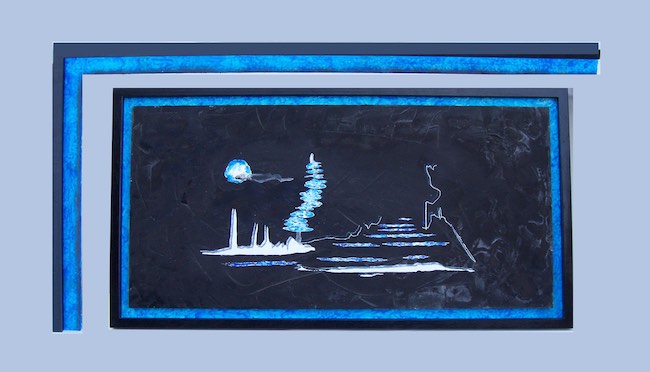
In Inverno invece lascia scorrere davanti a sé la raffigurazione di un luogo da cui si è sentito conquistato, avvolto malgrado le temperature della stagione a cui si riferisce la scena descritta, e sospende il paesaggio in uno spazio indefinito, senza inizio e senza fine, come enfatizzato dalla stessa cornice che ha due lati aperti proprio per infondere nell’osservatore il senso di appartenenza del panorama a un non tempo, a un luogo che rivive, ancora e ancora, nella memoria dell’artista. A dispetto del colore scuro dello sfondo emerge un senso di serenità dalla tela, la medesima sensazione di pace che ha provato l’artista nel momento in cui si è trovato a vivere il frangente narrato.
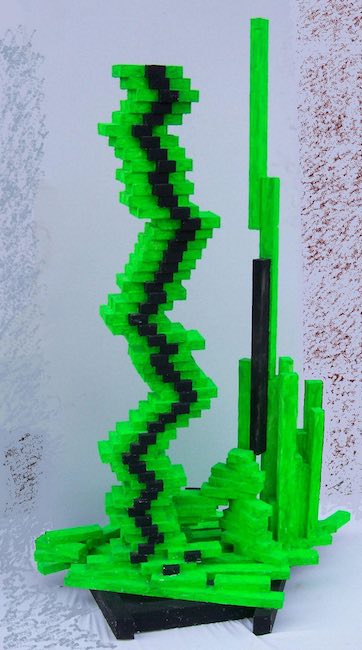
Ma l’opera che più di tutte esprime il concetto di Mariniello nei confronti del tempo è la scultura Lo scandire del tempo, in cui i tasselli di legno sono ricomposti per dar vita a un’immagine tortuosa, quasi contorta tanto quanto lo sono spesso i percorsi della vita, quel doversi piegare agli eventi o combatterli ma sempre arrendendosi all’ineluttabilità del concatenamento di causa ed effetto che contraddistingue l’esistenza di ciascuno; eppure, nonostante la contingenza sembri a volte indurre l’essere umano a soccombere, Giancarlo Mariniello non può fare a meno di far tendere la scultura verso l’alto, come se il progredire e l’evolvere fossero la parte positiva della medaglia di tutte le difficoltà in cui si può incorrere, come se senza quelle contorsioni e quei ripiegamenti su se stessi, che contraddistinguono la linea della scultura, non ci sarebbe l’innalzamento verso il cielo inteso come momento di crescita. E poi ancora l’artista affronta un’altra sfaccettatura del tempo, quella perdita che si lega all’incapacità di cogliere e di comprendere la rilevanza di una persona, di un’emozione alla quale si tende a dare poca importanza nel momento in cui è accanto, trascurando a volte di coltivarla nella convinzione di potervisi dedicare più avanti, quando l’impellenza degli altri impegni o delle altre priorità si sarà affievolita; ma quel dopo potrebbe non esservi mai, potrebbe essere troppo tardi per porre rimedio a ciò che ha provocato un allontanamento.
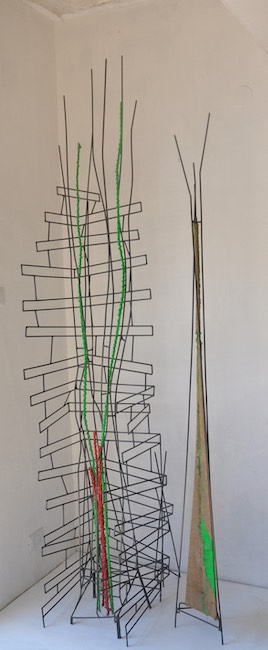
Questo è il senso della scultura L’amore evaporato costituito da una sottile struttura di metallo all’interno della quale Mariniello pone delle fiamme verdi che vanno verso l’alto a rappresentare la fine del sentimento, quel rosso che appare solo alla base della colorazione perché la sua intensità è stata lasciata a raffreddarsi, a estinguersi. L’abilità di Giancarlo Mariniello di misurarsi con differenti materiali è pari alla sua capacità introspettiva nel lasciar fuoriuscire le emozioni e le sensazioni che lo conducono a dare un’interpretazione delle varie sfaccettature del tempo, che lui chiama frammenti, e che coinvolge l’osservatore perché ne va a toccare le corde più profonde. Mariniello ha all’attivo molte mostre collettive e personali sia in Italia che all’estero, Copenhagen e Lisbona, e i suoi orologi hanno molti appassionati collezionisti in Romania, paese in cui abita da molti anni.
GIANCARLO MARINIELLO-CONTATTI
Email: office@frammenti1989.eu
Sito web: www.frammenti1989.eu
Facebook: https://www.facebook.com/frammenti1989
Giancarlo Mariniello’s fragments, to capture but also to let go of the infinite facets of time
The concept of the passing of time, of its fluidity or in some cases its immobility, has been addressed many times throughout the history of art, because after all it constitutes that thin thread on which the lives of individuals move without it being possible to discover its real consistency; in the contemporary era where everything seems to be brought back to the present moment, and not in the Eastern sense of appreciating the moment experienced but in the Western sense of not having a far-sighted vision nor being able to learn from the past, many artists feel the need to enter into that mysterious dimension, to explore it and to observe every aspect of it, every connection with their living. The artist I am going to tell you about today focuses almost his entire production on this ephemeral and at the same time indispensable element of existence.
In the course of the 20th century, the various artistic currents that dinamically flanked and followed one another, resulting in fact connected, if not from a stylistic point of view then certainly from that of the deepening of the psyche and interiority, introduced new meanings that had been lacking in previous art, apart from the brief interlude of Symbolism, which, however, had mainly dealt with contact with divine and supernatural energies, with the very essence of things around the human being; in the 20th century, on the other hand, all the movements that wanted to maintain contact with figuration, from Futurism to Surrealism, from Cubism to Metaphysics, introduced more existential concepts, more connected to a substantial awareness that in previous art seemed to have been left aside. Already in the group founded by Filippo Tommaso Marinetti and Umberto Boccioni, the guidelines highlighted the need to find a way to express the sense of movement and speed akin to the new modernity, to those early days of the century in which technological and scientific innovations had caused a rapid acceleration in the progress of society; time therefore entered directly into their artworks, constituting an essential element.
Salvador Dalì, on the other hand, repeatedly emphasised its fluidity, its literal melting because its flowing constituted an obsession of the great Catalan master, one of the few events, the rare circumstances that he could neither manage nor stem; in this case, therefore, the meaning was more negative than positive, which instead characterised Marinetti’s artworks, because the great Surrealist knew he had to bow to it despite his desire to resist and stop it. Yet immobile, almost post-apocalyptic atmospheres emerge from his canvases, in contrast to the awareness of the flow that enveloped his mind and became an obstacle to the carefree pursuit of pleasure in all its meanings. And again Cubism made use of the contemporaneity of observation, that of inducing the viewer to find himself simultaneously in front of a two-dimensional reality, thus eliminating the time to examine other sides of the portrayed faces, just as Giorgio De Chirico dealt with the immateriality of his settings, of that being suspended in an atmosphere in which past and present blurred, in which what had been silently became the background for what was preparing to be, instilling a sense of estrangement and solitude.
The Campania-born artist Giancarlo Mariniello is deeply attached to the concept of time, exploring it, however, through Abstract Expressionism, from a pictorial point of view, through Abstractionism from a sculptural point of view, and with Materic Informal when he mixes his natural curiosity about the passing of hours, days, years with an aptitude for creating objects that control but at the same time make one aware of its inexorable flow, such as the series of Orologi (Clocks) in which oil paint impregnates the wood to highlight the hours while in transparency moments, memories, small fragments that bind the middle ground between past and present become evident. Not only that, Mariniello is also fascinated by all the derivations and implications that arise from his observation of everything that is linked to the concept of flowing, of the perpetual fluidity within which circumstances follow one another, events that in the next juncture belong to memory. Even when he turns his attention to the essence of a moment he has lived or a person who has passed through his life, he always does so while allowing nostalgia to shine through, that belonging of each instant to an event or an encounter that belongs to the past and that seems to have left its wake in an existence that cannot help but go on, irrespective of the human being’s desire to want to stop it, to want to cling on to it to prevent the most pleasant moments from flowing away. In the painting Figura di donna (Figure of a woman) there is a subtle figuration, not of the female image mentioned in the title, but of the tree that constitutes the solid base of existence, but which can also be linked to the iconography of Genesis in which Eve is depicted as a temptress and it is from a tree that the serpent offers her the apple that will lead to her fall; in this canvas, Giancarlo Mariniello seems to paraphrase sacred scripture to emphasise the ambivalent soul and how, despite centuries having passed since that first event, the female essence has remained virtually unchanged, welcoming but often dangerously fascinating.
In Inverno (Winter), on the other hand, he lets the depiction of a place he has felt conquered by flow past him, enveloped despite the temperatures of the season to which the described scene refers, and suspends the landscape in an indefinite space, without beginning and without end, as emphasised by the same frame that has two open sides precisely to instil in the observer the sense of belonging to a non-time, to a place that lives again and again in the artist’s memory. In spite of the dark colour of the background, a sense of serenity emerges from the canvas, the same feeling of peace that the artist experienced at the moment he lived the narrated event. But the artwork that most of all expresses Mariniello’s concept of time is the sculpture Lo scandire del tempo (The passing of time), in which the wooden pieces are recomposed to create a tortuous image, almost as convoluted as the paths of life often are, that having to bend to events or fight them, but always surrendering to the inevitability of the chain of cause and effect that characterises each person’s existence; and yet, despite the fact that contingency sometimes seems to induce the human being to succumb, Giancarlo Mariniello cannot help but make the sculpture tend upwards, as if progress and evolution were the positive side of the coin of all the difficulties one may encounter, as if without those contortions and turning in on oneself, which characterise the line of the sculpture, there would be no upward movement towards the sky intended as a moment of growth. And then again the artist tackles another facet of time, that loss which is linked to the inability to grasp and understand the importance of a person, of an emotion to which one tends to give little importance in the moment in which it is near, sometimes neglecting to cultivate it in the conviction that one can devote oneself to it later, when the impellence of other commitments or other priorities will have faded; but that later may never be, it may be too late to remedy what has caused a distancing. This is the meaning of the sculpture L’amore evaporato (Love evaporated) made up of a thin metal structure inside which Mariniello places green flames that go upwards to represent the end of the feeling, that red that only appears at the base of the colouring because its intensity has been left to cool down, to extinguish. Giancarlo Mariniello’s ability to measure himself with different materials is equal to his introspective capacity in letting out emotions and sensations that lead him to give an interpretation of the various facets of time, which he calls fragments, and which involves the observer because it touches his deepest chords. Mariniello has many group and solo exhibitions to his credit, both in Italy and abroad, Copenhagen and Lisbon, and his clocks have many passionate collectors in Romania, where he has lived for many years.


